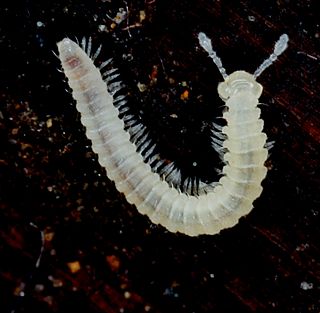
Millipedes are a group of arthropods that are characterised by having two pairs of jointed legs on most body segments; they are known scientifically as the class Diplopoda, the name derived from this feature. Each double-legged segment is a result of two single segments fused together. Most millipedes have very elongated cylindrical or flattened bodies with more than 20 segments, while pill millipedes are shorter and can roll into a tight ball. Although the name "millipede" derives from Latin for "thousand feet", no species was known to have 1,000 or more until the discovery of Eumillipes persephone, which can have over 1,300 legs. There are approximately 12,000 named species classified into 16 orders and around 140 families, making Diplopoda the largest class of myriapods, an arthropod group which also includes centipedes and other multi-legged creatures.
Causeyella youngsteadtorum, Youngsteadt's cave millipede, is a ghostly white millipede, first collected in 1976 by Norman and Jean Youngsteadt, but not recognized as a new species until 2003. It has been found in seven caves in Boone and Searcy counties in Arkansas.

Hellhole is a large and deep pit cave in Germany Valley of eastern West Virginia. It is the seventh longest cave in the United States and is home to almost half of the world's population of Virginia big-eared bats. At 737 feet (225 m), Hellhole is the deepest of several caves in the Valley.

Xystodesmidae is a family of millipedes. Its members often have very small distributional areas, with many species only known from a single locality. They are found across the northern hemisphere, with peak diversity in the Appalachian Mountains, where one-third of the 300 or so species occur. They are particularly abundant in deciduous broadleaf forests in the Mediterranean Basin, Africa, Asia, Central and North America, and Russia. Information on basic taxonomy is scant for this family; for example, it is estimated that the genus Nannaria contains over 200 species, but only 25 were described as of 2006. By 2022, 78 species in Nannaria have been described.

Motyxia is a genus of cyanide-producing millipedes that are endemic to the southern Sierra Nevada, Tehachapi, and Santa Monica mountain ranges of California. Motyxias are blind and produce the poison cyanide, like all members of the Polydesmida. All species have the ability to glow brightly: some of the few known instances of bioluminescence in millipedes.

Glomeridesmida is an order of millipedes in the infraclass Pentazonia containing 2 families and at least 31 species. Glomeridesmida is the only living order of the superorder Limacomorpha. Also known as slug millipedes, glomeridesmidans are small and somewhat flattened, and unlike other orders of Pentazonia, are unable to roll into a ball. Ocelli (eyes) are absent.

Anadenobolus monilicornis, known as the yellow-banded millipede or bumble bee millipede, is a species of millipede in the family Rhinocricidae. It is native to the Caribbean and has also been introduced to the southeastern United States.

Richard Lawrence Hoffman was an American zoologist known as an international expert on millipedes, and a leading authority on the natural history of Virginia and the Appalachian Mountains. He was a biology professor at Virginia's Radford College for almost thirty years, and curator of invertebrates at the Virginia Museum of Natural History for another twenty years. He co-founded the Virginia Natural History Society, described over 400 species of millipedes, and produced more than 480 scientific publications. He is commemorated in the scientific and/or common names of over 30 animal species, including the valley and ridge salamander and Hoffman's dwarf centipede.

Chordeumatida is a large order of millipedes containing some 1200 species with a nearly worldwide distribution. Also known as sausage millipedes, they grow and develop through a series of moults, adding segments until they reach a fixed number in the adult stage, which is usually the same for a given sex in a given species, at which point the moulting and the addition of segments and legs stop. This mode of development, known as teloanamorphosis, distinguishes this order from most other orders of millipedes, which usually continue to moult as adults, developing through either euanamorphosis or hemianamorphosis.
Branneria is a genus of small millipedes in the order Chordeumatida and the only genus in the family Branneriidae. Individuals reach about 4 mm (0.16 in) long. There are two species known, found in the southeastern USA: Branneria bonoculus is found in Arkansas and eastern Texas while B. carinata occurs from North Carolina to Florida and Mississippi. The adult B. bonoculus millipede has 28 body segments, and the adult B. carinata millipede has 26, both fewer than the 30 usually found in the order Chordeumatida. In both species, the gonopod complex in adult males includes three leg pairs rather than just the two that are usually modified into gonopods in this order.

Harold Frederick Loomis was an American botanist and myriapodologist known for his contributions to agronomy, plant pathology, and millipede taxonomy. He worked for the U.S. Department of Agriculture for over four decades, studying diseases of crop plants, and was a colleague of Orator F. Cook. He also made major contributions to the natural history of Central America and the West Indies, naming over 500 species of millipedes in total. He co-described with Cook the leggiest animal on earth: Illacme plenipes, with over 700 legs.
Floridobolus is a genus of millipedes commonly known as Florida scrub millipedes containing three described species: Floridobolus penneri, F. orini, and F. floydi; the latter two described in 2014. All three species are endemic to Florida scrub habitat of peninsular Florida, and F. penneri is considered a critically imperiled species by NatureServe. Prior to the description of F. orini, the genus was considered the sole member of the family Floridobolidae, named by William T. Keeton in 1959, however studies in 2014 have argued that Floridobolus does not represent a distinct family but rather is a basal member of the family Spirobolidae, representing the subfamily Floridobolinae, and tribe Floridobolini.

Titanophyllum spiliarum is a species of cave-dwelling millipede in the family Julidae. The only known species of the genus Titanophyllum, it was described in 2011 from specimens discovered in a cave in Greece. It has several unusual characteristics including eyelessness and a small hook on its hind-most body section that may be involved in keeping the animal ‘locked’ when it coils-up defensively.
William Albert Shear is Trinkle Professor Emeritus at Hampden-Sydney College, Virginia. He is a spider and myriapod expert who has published more than 200 scientific articles primarily on harvestman and millipede taxonomy.
Cleidogonidae is a family of millipedes in the order Chordeumatida. Adult millipedes in this family have 28, 29, or 30 segments. This family includes the genus Tianella, notable for featuring adult millipedes with 29 segments, a number not found in the adults of any other chordeumatidan species. All Tianella species have adults with 29 segments except for two in which adults have only 28 segments. In the Tianella species with 29 segments, adult females have 48 pairs of legs, as one would expect in adult female chordeumatidans with one segment fewer than the 30 usually found in this order. There are seven genera and at least 140 described species in Cleidogonidae.

Conotylidae is a family of millipedes in the order Chordeumatida. Adult millipedes in this family have 30 segments. There are about 19 genera and at least 60 described species in Conotylidae.

Striariidae is a family of millipedes in the order Chordeumatida. Adult millipedes in this family have 30 segments. There are at least 3 genera and about 13 described species in Striariidae.
Tingupidae is a family of millipedes in the order Chordeumatida. Adult millipedes in this family have 28 or 30 segments. There are 2 genera and 13 described species in Tingupidae.
Trichopetalidae is a family of millipedes in the order Chordeumatida. Adult millipedes in this family have 28 or 30 segments. There are about 5 genera and at least 30 described species in Trichopetalidae.
David A. Hubbard, Jr is an American speleobiologist and karst geologist, exploring and documenting speological sites and life forms around Virginia and Maryland. He has published on phenomenon of burial caves, in particular by the indigenous peoples of Virginia, as well as the use of caves by human beings over the past 10,500 years.













